How Much & How Often to Water Poinsettias? Practices, Factors, & FAQ
-
Pete Ortiz
- Last updated:
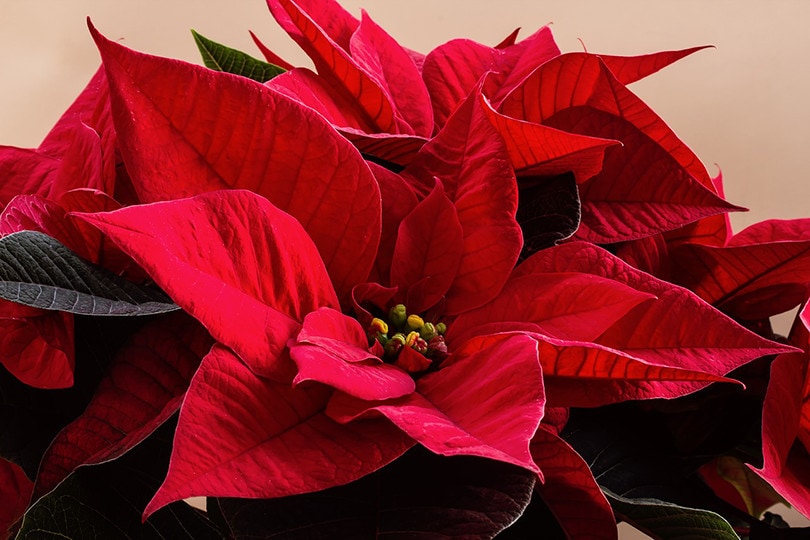
No plant embodies the beauty, magic, and splendor of the festive season quite like poinsettias. This popular holiday plant is a staple for households across the country during Christmas. Its large, colorful bracts (said to symbolize the Star of Bethlehem) beautifully adorn our doors to usher in the season of giving.
While poinsettias are certainly a sight to behold, taking care of them is easier said than done. Underwatering or overwatering your poinsettias will lead to their untimely death, which begs the question, “How much and how often should I water my poinsettias?” Keep reading to find out.
How Often Should I Water My Poinsettias?
Poinsettias are indigenous to Mexico and parts of Central America, characterized by warm temperatures, humidity, and little rainfall. Like other plants, poinsettias evolved to thrive in their indigenous environment. It’s up to you to mimic their natural environment as best as you can for them to thrive.
Poinsettias are very sensitive to under watering and overwatering. Only water them once a week by applying water until you soak the soil in the pot. Add an extra inch of water to prevent the soil from drying out between watering intervals.
It’s important to only water the plants once a week. Too much water precludes the roots from taking in oxygen, leading to root rot. However, it’s worth noting that different factors affect how often you should water your poinsettias.
- Humidity– The more humid your home is, the less water plants lose through their leaves. If you live in a humid environment, it’s best to go slow with watering your poinsettia. Try watering once every 10 days and see how the plant reacts.
- The Soil’s Water-Holding Capacity – Soils with finer particles, like clay, retain water much longer than those with coarse particles. Reduce the watering frequency if your soil feels clayey to avoid overwatering your plant. Do the opposite for sandy soils that don’t hold water for long.
- Wind – Strong winds accelerate water loss from the poinsettia’s leaves. If you live in a windy area, you’ll want to water your plant a lot more often.
- The Pot’s Size – Poinsettias in smaller pots need to be watered more frequently. That’s because smaller pots tend to dry up a lot quicker.
To check whether your poinsettias need watering, just rub your finger on the top layer of the soil. If the soil feels dry, it’s time to water the plant. If it feels moist, postpone the watering to another day.
It’s important to water your poinsettias throughout the year. In the cold winter months, make sure you water your poinsettias more often. That’s because heaters accelerate water loss from poinsettia’s leaves. You’ll have to increase the watering frequency to counter the water loss.
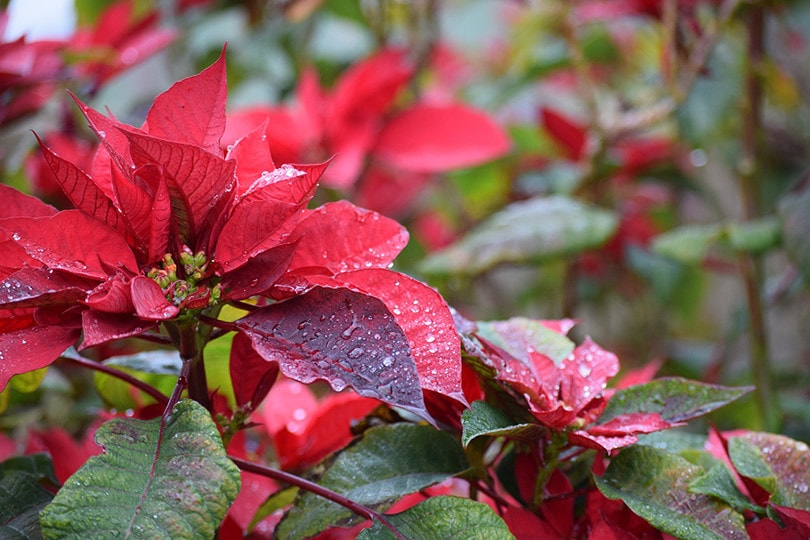
How Much Water Should You Give Your Poinsettias?
Again, you’ll want to be careful with how much water you pour into your poinsettia’s pot. Too much water and the plant gets root rot. Too little water and the leaves start turning yellow. So, how much water should you give your poinsettias?
While external factors influence how often you should water your poinsettias, the amount of water you give them should always remain constant. When watering your poinsettias, you want to give them a generous douse. This will ensure enough water to sustain the plant until the next watering session. The excess will trickle down the base of your pot, where you can discard it.
Most people make the mistake of underwatering their poinsettias, and it’s hard to blame them. When you water your plants, there’s always an inch-high layer that remains above the soil. This gives the impression that the soil has soaked up enough water when it really hasn’t.
Water takes a lot longer to infiltrate soil with fine particles, hence the water layer. After watering your soil, give it at least 30 minutes to let all the water infiltrate the soil. Keep this up until the water remains on top of the soil, even 30 minutes after watering.
Make sure you allow the soil to sufficiently dry before you water it again. Doing so helps mimic the rainfall cycle in the plant’s indigenous environment, where periods of rain are spaced between dryer periods.
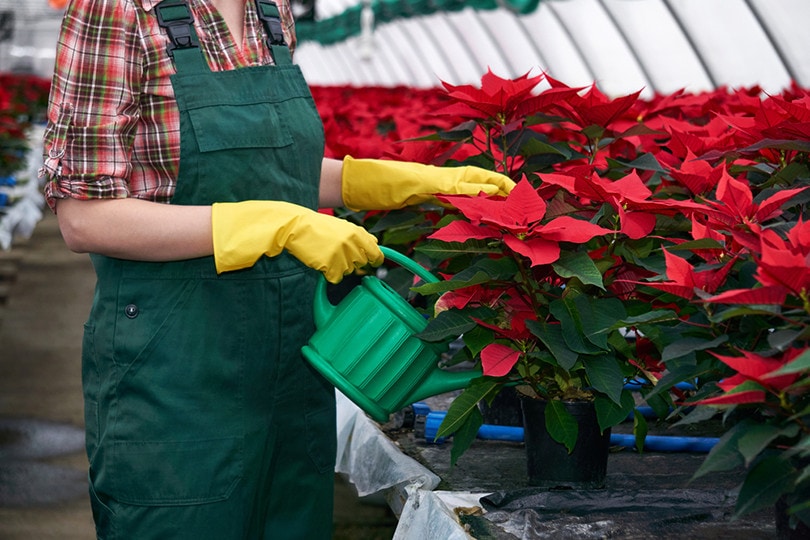
Best Practices for Watering Poinsettias
Growing healthy and thriving poinsettias requires a significant amount of effort and commitment. Here are a couple of best practices for watering your poinsettias to ensure they flourish.
Use Pots With Drainage Holes
Very damp soil is detrimental to your poinsettia’s growth. As mentioned earlier, excessive moisture in the soil leads to root rot. This occurs when parts of the root die off because of insufficient oxygen. The decay spreads to other parts of the plant and eventually kills it.
Always plant your poinsettias in a pot with drainage holes. That way, any excess water can spill into the saucer at the pot’s base. It’s also important to discard any excess water in the saucer. Leaving the water to linger is just the same as having no drain holes at all. If you don’t want to make a mess, try using a turkey baster to remove the excess water.
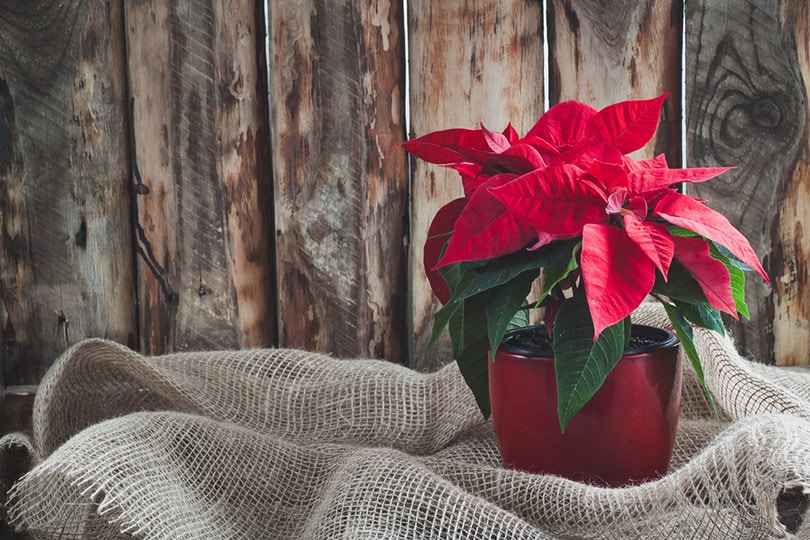
Never Use Softened Water
Some people like to use softened water for their plants. This follows an ill-conceived notion that softened water is pure, hence better for the plants. However, softened water contains too much sodium, which may be harmful to the plant.
The water softening process involves treating water with sodium and potassium. While these elements are beneficial to humans, they’re detrimental to plants, especially in excess. That’s why you should avoid dousing your poinsettias with soft water.
Pouring soft water on your poinsettias won’t immediately kill them. However, continually pouring soft water on the plants will eventually do so. The excessive sodium will upset the plant’s water balance. This “fools” the poinsettias into thinking that they have taken up enough water when they haven’t. Eventually, they die of thirst.
Aim for the Soil, Not the Leaves
Don’t make the mistake of watering your poinsettia’s leaves instead of the soil. While doing so seems harmless, it may have adverse effects on the plant’s health. Watering the leaves makes your plant more susceptible to diseases, particularly bacterial infections. It also results in wastage since a significant amount of water will remain on the leaves.
Instead of watering the leaves, point your watering can at the soil and water away. Too much water on the leaves can lead to the growth and proliferation of mold. This is not only insightful but also compromises your poinsettia’s health. If you notice any signs of mold growth on your poinsettia’s leaves, stop watering the leaves immediately and get a proper fungicide for the mold.
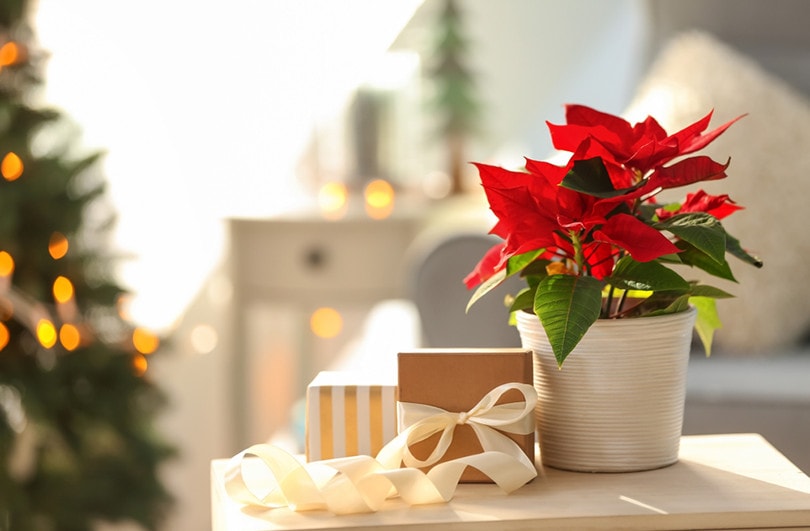
Don’t Skimp on the Poinsettia’s Pot
Like humans outgrow their clothes, so do plants outgrow their pots. Most people buy poinsettias in their grower pots. These pots provide a safe haven for the plant, but only for a while. Sooner or later, the plants become too big for their pots. When they do, their roots become bound to the container.
Ensure you swap your grower’s pot for a bigger one with drain holes after buying your poinsettia. If you don’t, the small pot will inhibit the plant’s growth and also make it more vulnerable to diseases. Smaller pots are also much harder to water.
Invest in a high-quality ornamental pot for your poinsettias, so they can breathe freely and look their best in your home. Growing them in their grower pots is an absolute no-no.
Top Your Soil With Tiny Pebbles
A layer of small pebbles on top of your poinsettia plant’s soil isn’t just for decorative purposes. The tiny pebbles also act as a barrier, preventing the excessive loss of moisture from the soil via evaporation. You can find these pebbles on sale in garden stores and tree nurseries across the country.
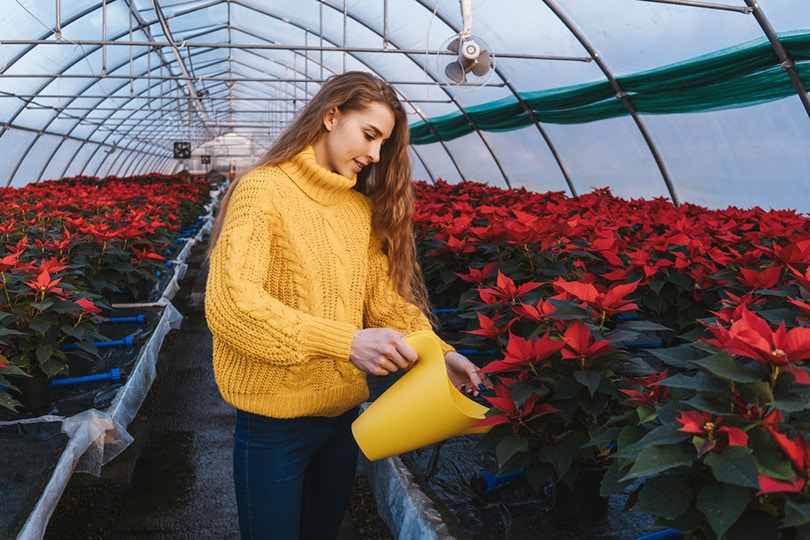
Be Extra Cautious During Winter
Winter is a brutal time for poinsettias and many other plants across the country. As such, you’ll need to take good care of your poinsettias to see them through to the next year.
First things first, you want to position your plant far away from the window. Not so far that it barely receives sunlight, but far enough to protect it from draughts. Draughts can easily lead to the loss of leaves or the death of your plant.
It’s also absolutely important that you avoid watering your poinsettia’s leaves during winter. Combining wet leaves with the winter draft is a recipe for disaster.
Final Thoughts
Poinsettias are beautiful plants that bring cheer and delight to our holiday celebrations. That’s why it’s super important to take good care of them to keep them healthy and flourishing. The information above should help you do just that.
Remember, only enough water at the right intervals will do. Anything less or more than enough is harmful to your plant.
Featured Image Credit: angelinaelv, Pixabay
Contents



